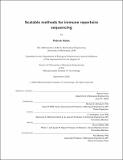| dc.contributor.advisor | Birnbaum, Michael E. | |
| dc.contributor.advisor | Love, J. Christopher | |
| dc.contributor.advisor | Walker, Bruce | |
| dc.contributor.author | Holec, Patrick | |
| dc.date.accessioned | 2023-03-02T19:34:45Z | |
| dc.date.available | 2023-03-02T19:34:45Z | |
| dc.date.issued | 2022-09 | |
| dc.date.submitted | 2023-02-07T20:24:26.913Z | |
| dc.identifier.uri | https://hdl.handle.net/1721.1/148289 | |
| dc.description.abstract | Our immune system is a complex network of cells and proteins designed to identify and eliminate cancer and infection. At the center of this lies the interaction between the T cell receptor (TCR) and antigens presented through peptide-major histocompatibility complexes (pMHCs). Our ability to detect disease relies on the heterogeneity found on both sides of this equation, yet technologies to characterize either antigen presentation or TCR diversity at a repertoire scale are rarely economical or scalable.
In this thesis, we discuss two separate advances in immune repertoire sequencing. In the first aim, we describe a high-throughput tool to identify antigenic peptides capable of being presented on class I MHCs. This platform utilizes yeast surface display as a means to separate binding peptide from non-binding peptide. We then use this technique to screen for antigenic peptides derived from multiple pathogen proteomes across eighteen MHC alleles, resulting in a catalog of new antigens to further characterize. In my second aim, we explore integrated experimental and computational approaches for sequencing TCR repertoires. To do this, we focus on algorithmic approaches to recover TCRα and TCRβ pairings in noisy datasets. By developing a new Bayesian framework, we are able to increase pairing efficiency and computation speed. Finally, we describe how this framework primed the development of a novel T cell sequencing strategy. This method, spatial TCR deconvolution, amplifies TCR transcripts from cells lysed in solution and uses barcoded beads as a molecular beacon to record spatial proximity. Preliminary results suggest the barcoded transcripts produced have the potential to recover TCR pairings at scale. | |
| dc.publisher | Massachusetts Institute of Technology | |
| dc.rights | In Copyright - Educational Use Permitted | |
| dc.rights | Copyright MIT | |
| dc.rights.uri | http://rightsstatements.org/page/InC-EDU/1.0/ | |
| dc.title | Scalable methods for immune repertoire sequencing | |
| dc.type | Thesis | |
| dc.description.degree | Ph.D. | |
| dc.contributor.department | Massachusetts Institute of Technology. Department of Biological Engineering | |
| dc.identifier.orcid | 0000-0003-2342-7616 | |
| mit.thesis.degree | Doctoral | |
| thesis.degree.name | Doctor of Philosophy | |
